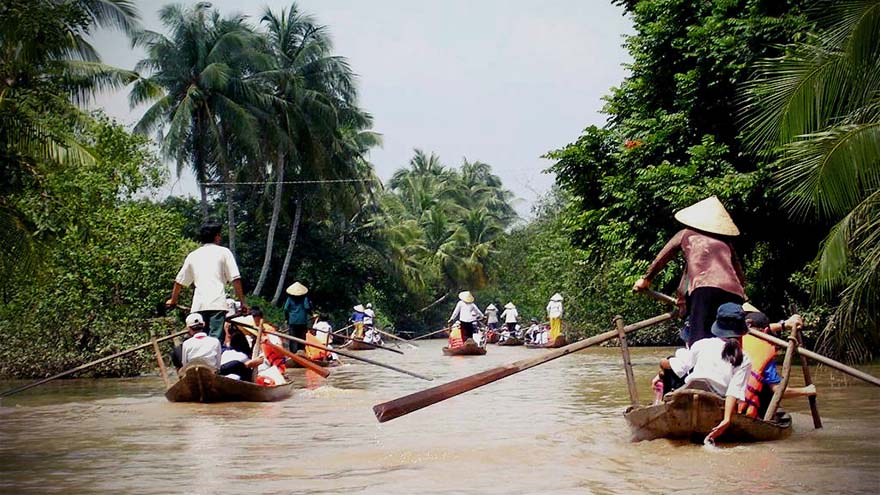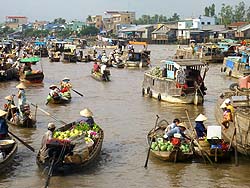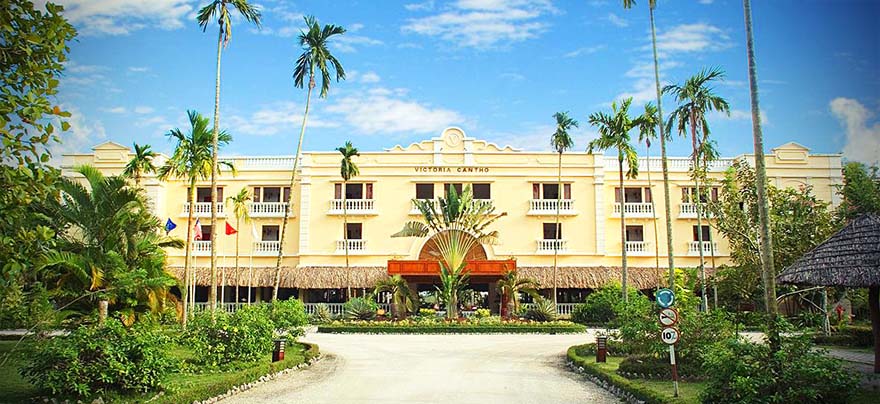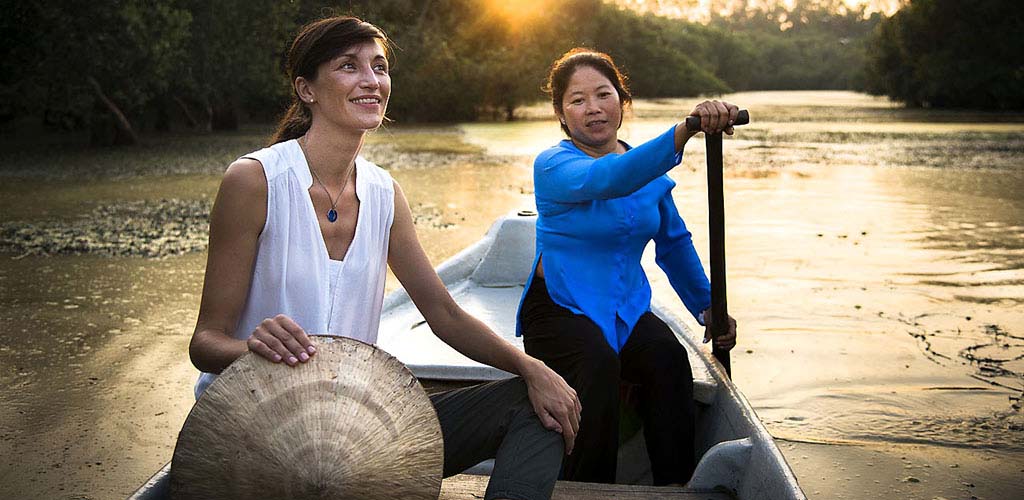MEKONG | THE RIVER OF THE NINE DRAGONS
As the Mekong River enters Vietnam from Cambodia it splits into two channels, which the Vietnamese call the Tien Giang (Upper River), and Hau Giang (Lower River) and the the river continues to divide as it traverses the soggy delta, an enormous fertile area of almost 50,000 square kilometers. By the time it empties into the South China Sea, it has seven branches, or mouths (formerly nine).
Two others have silted up over the years, but because nine is an auspicious digit, the Vietnamese name for the river is still Coo Long, or "River of the Nine Dragons." Thousands of streams and canals linked to the Nine Dragons are the main streets and irrigation canals of the delta. Rich silt deposited by the Mekong and its tributaries created the delta, an area that holds a fifth of Vietnam's population and supplies half its rice crop, including a booming export trade with surplus rice from the south traditionally supplying the rice-poor north or been shipped abroad. Other crops include coconuts, sugarcane, and fruit and fishing is also a major industry.
With a profusion of tropical fruit in the Mekong delta, there are bound to be some exotic varieties. A unique species of vegetation lining the delta's canals is the water coconut palm. The fruit of the palm (dua nuoc) hangs close to the ground, and at first sight resembles a husky pinecone. Edible, transparent, fleshy pieces are embedded in the rough segments of the water coconut and are revealed only after the fruit is cracked open. Another variety found in the Ha Tien area is called thot lot, with blubbery, opaque pieces embedded in three sides of a small, purplish brown coconut. Instead of cutting this coconut in half for you to eat, the vendor slices off the sides. The coconut contains no milk; its flesh is served in a glass with ice and sugar. With its extensive reed beds, lakes, and mangrove forests, the delta is home to many species of rare birds, among them kingfishers, red-headed cranes, and eastern saurus cranes.
The delta also seems to be a breeding ground for odd religions. Besides an eclectic range of Buddhist temples, Catholic churches, and Islamic mosques, there are many Cao Dai temples in the delta. Hoa Hao Buddhism emerged in the delta area, with a large number of devotees around Chau Doc.

All around the ferry is the river, it's brimful; its moving waters sweep through, never mixing with, the stagnant waters of the rice fields. The river has picked up all it's met with since Tonle Sap and the Cambodian forest. It carries everything along, straw huts, forests, burned-out fires, dead birds, dead dogs, drowned tigers and buffaloes, drowned men, bait, islands of water hyacinths all stuck together. Everything flows towards the Pacific, no time for anything to sink, all is swept along by the deep and headlong storm of the inner current, suspended on the surface of the river's strength.
Marguerite Duras describing the swirling waters of the Mekong in her novel, The Lover, set during the 1920s. Duras' hometown was Sadec, where embassy staff had left behind files on those who worked for them, making it easy for the north to identify collaborators.
Mekong Delta Touring

The Mekong Delta's unique water culture is unique for Vietnam, and on a vast scale. Here small sampans navigate thousands of small canals, to market, small towns, and island farms. Stilted houses line the rivers and most fascinating of all are the busy floating markets with in some cases, such as Cai Rang, hundreds of colorful boats zigzagging and maneuvering in to sell or buy guides. The early morning, at market's peak, is the best time to visit and for photography. To witness this, we recommend overnighting in Can Tho at the pleasant French-operated hotel Victoria.
A few of our favorite experiences and activities in the Mekong Delta:
- Cycling (see below). The Mekong provide for warm sunshine year round when other places may be too cool or wet, with a full variety of rides from leisurely back country spinning along village footpaths to century rides to the far southern tip.
- Floating markets. Nobody ever forgets their first glimpse of hundreds of loaded boats zig-zagging across the river, jostling for position to sell and buy all manner of goods.
- The Victoria Can Tho. A luxurious oasis on the banks of the Mekong with charming, period rooms (below)
- Exotic tropical fruits. You're sure to sample at least one fruit you've never even seen or heard of in the Mekong Delta, from rambutan, mangosteen, jack, dragon, water apple, lychee, star, sugar apple, longan, passion and varieties of bananas non existent in the West.
- Crusing to Cambodia. By all means, avoid backtracking all the way to Saigon and continue on to Phnom Penh, currently one of Asia's most interesting cities.

Mekong Delta Bicycle Tours
To really experience the Mekong Delta, cruising by boat only provides a partial glimpse. To really enjoy the vivid, emerald-green vistas of endless rice paddies and up close glance of villages, farms and markets, bicycling is the ideal way to explore.
We've organized high-end bicycle tours of the Mekong Delta since 1993, the first North American company to do through our adventure wing, VeloAsia, and although we've branched out with trips all over Southeast Asia since then, we always enjoy and recommend cycling the pancake-flat delta it's vast network of pleasant footpaths away from motor traffic ( wonderful and safe for families with children of all ages—above, the Bellinghams with one of two boys). Our cycling trips combine easy cycling days, boat cruises (making all the early floating markets in Cai Rang, Can Tho, and Chau Doc), and luxury accommodation at riverfront resorts. Our 3-4 day Mekong Delta bike tours travel one way, deep into the Mekong where fewer travelers venture and then taking a scenic 4-5 hour cruise to Phnom Penh, Cambodia from the Vietnamese border. From Phnom Penh, Angkor or a return to Saigon is a short flight away.
Mekong Delta Cruising
With us carefully planning your boat charter, cruising on Halong Bay will be one of life's great travel experiences, and should definitely be on your itinerary. The Vietnamese are Asia's most gregarious, friendly, and fascinating. One should not miss getting up close and personal as much as possible and we recommend considering an overland trip with a combination of short cruises, which enables you to see what is most interesting on the river and hundreds of small canals, such as the floating markets, yet also get into the villages and markets. If you enjoy activity, cycling in the Mekong is leisurely and pleasant (above).
In the last few years a handful of luxury boat companies have cropped up serving the Cai Be to Phnom Penh route (and further up to Siem Reap to explore Angkor). The finest quality cruise is offered by the Aqua Mekong, a newer venture launched in 2014 by Aqua Expeditions that has organized cruises in Peru. The Aqua Mekong offers 3 to 7-night cruises aboard its Aria Mekong Cruise Ship in twenty suites.
Phu Quoc Island Paradise
From the delta, is it possible to fly or ferry to Phu Quoc, an enormous island of over 400 square miles that is actually situated off the coast of Cambodia. Pho Quoc remains pleasantly undeveloped, a Koh Samui of thirty years ago (read more about Phu Quoc). Also consider the Song Saa, located on a small private island south of Cambodia as well.
When to go?
Unlike much of Vietnam, the Mekong Delta provides pleasant touring year-round, although very hot during April and the summer months. Rain is far less than the northern areas, and even during the monsoon season (August and September), welcome showers typically arrive in the afternoon for only a brief period.
As the waters of the mighty Mekong River reaches the end of its nearly 2,700 journey from the Tibetan Plateau, it enters Vietnam from Cambodia it splits into two channels, which the Vietnamese call the Tien Giang (Upper River), and Hau Giang (Lower River) . The the river continues to divide as it traverses the soggy delta, an enormous fertile area of almost 50,000 square kilometers and by the time it empties into the South China Sea, it has seven branches, or mouths. Thousands of streams and canals linked to the Nine Dragons are the village "main streets" and irrigation canals of the delta. The rich silt deposited by the Mekong and its tributaries created a fertile delta, an area that holds a fifth of Vietnam's population but supplies half its rice crop, while being the world's largest exporter trade of rice after India.
With a profusion of tropical fruit in the Mekong delta, there are bound to be some exotic varieties. A unique species of vegetation lining the delta's canals is the water coconut palm. The fruit of the palm (dua nuoc) hangs close to the ground, and at first sight resembles a husky pinecone. Edible, transparent, fleshy pieces are embedded in the rough segments of the water coconut and are revealed only after the fruit is cracked open. Another variety found in the Ha Tien area is called thot lot, with blubbery, opaque pieces embedded in three sides of a small, purplish brown coconut. Instead of cutting this coconut in half for you to eat, the vendor slices off the sides. The coconut contains no milk; its flesh is served in a glass with ice and sugar. With its extensive reed beds, lakes, and mangrove forests, the delta is home to many species of rare birds, among them kingfishers, red-headed cranes, and eastern saurus cranes.
The delta is also a breeding ground for odd religions. Besides an eclectic range of Buddhist temples, Catholic churches, and Islamic mosques, there are many Cao Dai temples in the delta. Hoa Hao Buddhism emerged in the delta area, with a large number of devotees around Chau Doc.
"All around the ferry is the river, it's brimful; its moving waters sweep through, never mixing with, the stagnant waters of the rice fields. The river has picked up all it's met with since Tonle Sap and the Cambodian forest. It carries everything along, straw huts, forests, burned-out fires, dead birds, dead dogs, drowned tigers and buffaloes, drowned men, bait, islands of water hyacinths all stuck together. Everything flows towards the Pacific, no time for anything to sink, all is swept along by the deep and headlong storm of the inner current, suspended on the surface of the river's strength.
Marguerite Duras described the swirling waters of the Mekong in her novel, The Lover, set during the 1920s. Duras' hometown was Sadec, where embassy staff had left behind files on those who worked for them, making it easy for the north to identify collaborators.
Mekong Delta Touring
The Mekong Delta's unique water culture is unique for Vietnam, and on a vast scale. Here small sampans navigate thousands of small canals, to market, small towns, and island farms. Stilted houses line the rivers and most fascinating of all are the busy floating markets with in some cases, such as Cai Rang, hundreds of colorful boats zigzagging and maneuvering in to sell or buy guides. The early morning, at market's peak, is the best time to visit and for photography. Overnighting in Can Tho at the pleasant French-operated hotel Victoria.
A few of our favorite experiences and activities in the Mekong Delta:
-
Cycling (see below). The Mekong provide for warm sunshine year round when other places may be too cool or wet, with a full variety of rides from leisurely back country spinning along village footpaths to century rides to the far southern tip.
-
Floating markets. Nobody ever forgets their first glimpse of hundreds of loaded boats zig-zagging across the river, jostling for position to sell and buy all manner of goods.
-
The Victoria Can Tho. A luxurious oasis on the banks of the Mekong with charming, period rooms (below)
-
Exotic tropical fruits. You're sure to sample at least one fruit you've never even seen or heard of in the Mekong Delta, from rambutan, mangosteen, jack, dragon, water apple, lychee, star, sugar apple, longan, passion and varieties of bananas non existent in the West.
-
Cruising to Cambodia. By all means, avoid backtracking all the way to Saigon and continue on to Phnom Penh, currently one of Asia's most interesting cities.
Mekong Delta Accommodations
The French Victoria chain features a property near to the city of Can Tho, the perfect base for exploring local villages, floating markets, and taking short cruises on the Mekong. A tranquil retreat on the banks of the Hau River, the lovely setting boasts colorful gardens of tropical plants.
